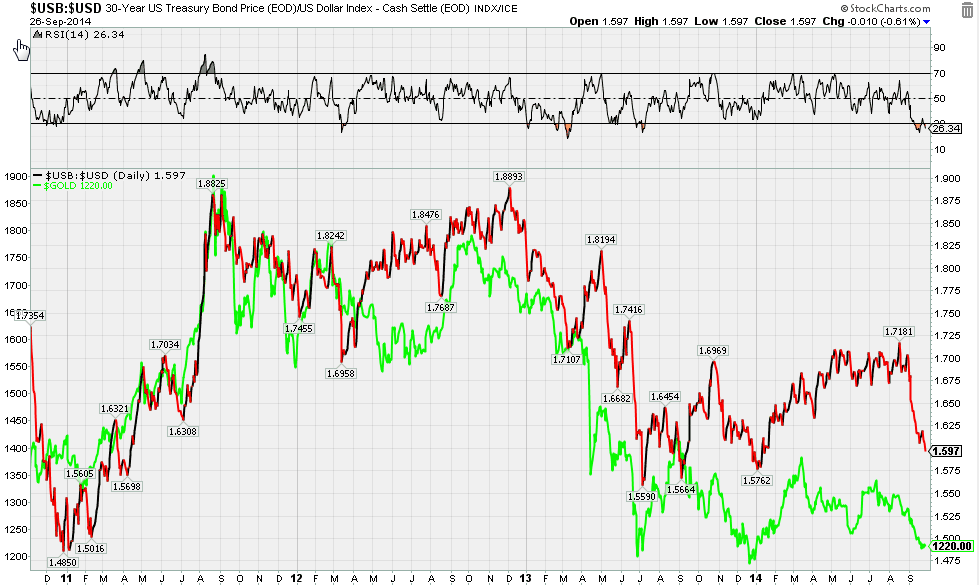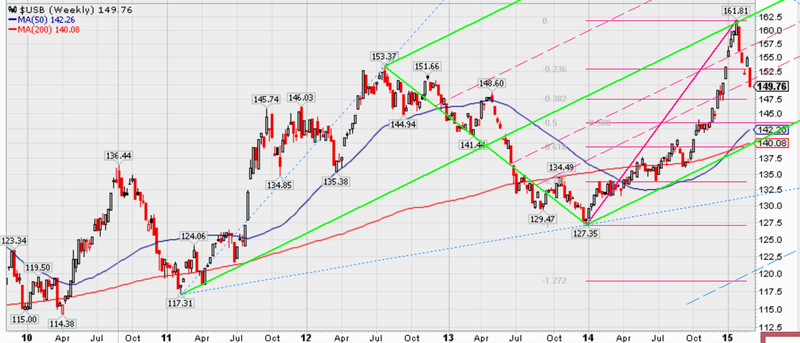Putting the pieces together Big Bad Bear Bond Market Coming
Post on: 22 Июль, 2015 No Comment

Archives
February 12, 2011
Big Bad Bear Bond Market Coming?
In 1981 30 year US Treasury bonds were sold over 14% and were non-callable. Right after gold and most of the commodity asset sectors crashed into a greater than twenty year bear market in 1980, one could buy these incredible bonds. If held to maturity this year one would have collected 14% every year or 420% total and have been paid back the bond price in full. This is a bond bull market that happens once in a lifetime. The previous bond bull market like that ran from 1921 to 1946.
According to Kondratieff cycle analysis treasury bonds should have topped sometime between 1998 and 2004. During that time, gold and most commodities did bottom, and in 2002-2003 stocks bottomed and bonds appeared to have topped, all on schedule. Until 2008 I was pretty certain bonds really had topped, as long term readers know. But the very short term inter-bank credit market completely shut down in 2008 and the central bank and treasury totally backstopped the clearing process by flooding the financial institutions with nearly free reserves in all the ways we have come to know. That and the flight to the safety in treasurys created two big spikes in bond prices in late 2008 and in mid 2010.
Since August of last year the 30 year treasury bond has fallen 14% in price and the prevailing rate for the same bond has risen from 3.52% to 4.75%. This is a sizeable move, but as you can see from the long term chart, the constant 30 year bond has not yet fallen through its uptrend line since 1987. There have been larger declines than since August 2010 in the 30 year bond in 1986-87, 1993-94, and 1998-99 which define the trend line.  
Until the bond does fall through that trendline, it is premature to call an end to the grand bull market from 1981. But its not too early to consider the implications of that possible break down in bonds and how it would affect an income portfolio. Roughly a 1.23% rise in rates resulted in a 14% decrease in the bonds price in five months, which would annualize to a 27.32% decline. This ratio of price decline to interest rate change is what is referred to as a  bonds duration, and for the 30 year bond currently that duration, usually quoted in years, is very close to the 30 year maturation of the bond. Every subsequent 1% rise in the bond interest rate would likely result in a 25-30% bond price drop.
If your intent always was and is to hold individual bonds until maturity, you may not care at all what the price does since your income will remain the same every year. But if you look at the low price of the 30 year bond in 1981-82, youll get an idea of how your bond asset value could suffer a massive drop if rates rose from under 5% to 14% in coming years. And that huge asset loss would be compounded by the fact that rising bond yields are often associated with greatly rising inflation rates! I learned from my father what devastation the bond bear market from 1946 to 1981 did to the finances of my grandfathers and grandmothers last years. Thats why bonds were referred to as guaranteed certificates of confiscation by Dr. Franz Pick and others. Stock bear markets are devastating too, but bond bear markets go on and on for decades. Thus thinking about a bond bear market is not a frivolous or academic exercise. For a retired person its an issue for financial survival.
The Federal Reserves great backstop of the banks has been the great backstab of savers and retired people. When you hear that federal tax rates have been steady to lower over the past three years, please feel free to laugh very loudly. Our central bank has plundered savers and retirees and many others to prop up favored banks. It looks like a massive tax to me. One favored approach to investment retirement has always been bank CDs and money market mutual funds (MMMFs), but the rates are laughably low indeed as many of you will have discovered in this season when you received 1099s and other documents to use in your federal income tax return preparation.
Just as generic stocks have rebounded over the past two years of cheap and easy money, courtesy unwillingly of savers, corporate bonds and particularly high yield bonds have risen greatly, and many yield searchers have gone for them, including myself. High yield corporates have only slightly lagged the SP500 and only lagged until the past few months. (High yield corporates give investors what corporate managements should give to shareholders but which they often do not, and which not infrequently they waste on frivolous ventures, lose, or bonus to themselves. As a result, and over some very long periods of time, total returns with dividends reinvested of corporate high yield bonds outperform or hold their own with generic stock indexes. See charts.)
If we enter a true bond bear market, even high yield bonds and stocks will eventually suffer for several reasons: first, shorter term or shorter duration notes and bonds will draw money away from stocks due to their rising yields and lower volatility; and second, higher interest rates are negative for corporate profits at some point. But dont expect higher rates to impact generic stock prices very soon! Keep in mind that interest rates rose for most of the 1950s, 60s, and 70s, but stocks were not impacted in any major way until 1969-72 and beyond. Stocks can go down this year, but it wont be due to rising rates until short term rates go somewhere above 4-6%. Thus high yield bonds can remain good cash payers for some time even if their capital gains returns level off. But if a serious stock decline begins at any point and generic bonds are also falling, high yield bonds will follow if not lead.
If one can afford it, a higher than normal holding of MMMFs or TBills is a good policy. It allows the prudent investor to buy when bargains occur. Besides retreating to nearly zero interest rate TBills or MFMFs while waiting for rates to climb, and venturing to short term notes or bonds, what else can an income investor do? The first advice one often hears is to buy inflation-adjusted treasurys (TIPs). One fault of this advice is that TIPs are treasurys too, so if treasurys enter a bear market, so will TIPs until inflation gets high enough to overcome the treasury bear market trend. TIPs only became accessible for private investors after 1981, so we dont have any bear market history to learn from, and must use logic instead. If inflation grows rapidly, TIPs will lag due to delayed reporting, the delayed time for adjustment of the inflation bond after delayed reporting, and a poorly constructed US official inflation index that is widely believed to under-report inflation.

For the past three months, the bond market is discounting the probability of near term higher inflation (dark blue line is Vanguards TIPs chart) and highlighting the possibility of rising interest rates. (The light purple line is PIMCOs floating rate bond fund. (BP is the annualized total return based on the last three months.) That divergence is one reason I am leaving inflation out of this discussion so that I can focus on interest rate strategies in a possible bond bear market. The three month chart gives several clues. Both LSBDX and PIMIX are relatively higher yield funds but with mostly investment grade bonds. They are still giving very good results as they have for several years. I own both of these plus PTTRX, a five to seven year duration fund, although I have cut back in that fund considerably since last summer. Im guessing that PIMCO would like to shrink this enormously big funds assets and have people gradually shift into other PIMCO funds.  
PTSHX is a short term PIMCO fund with an effective duration less than one year, recently reported at 0.84 years. It pays about 1% annually on a monthly schedule with about a 0.5% gains dividend at the end of 2010. Keep in mind that this is at least 10 times higher than the maximum 0.25 duration (3 months) MMMF is paying. Vanguards VFSUX (short term corporates) or VFIJX (short term GNMAs) of two to three years duration are paying about 3%. So these are three fairly short duration wait and see places to sit in for part of an income portfolio. I own the last two and only recently became aware of PSHTX. The best three month results in this list were from PFIIX, whose benchmark is the three month LIBOR rate. It is paying about 3% with an imputed duration of less than a year at 0.89 duration. I have just started buying this fund and may add a lot more.
So I am acculumlating cash, short term bond funds, and adjustable rate funds (both mutual and closed-end and a few individual issues) based on huints I am getting from the markets. With Chairman Bernanke on a treasurys buying spree with a wallet full of credit cards and a bigger printing press, bonds may come down to that decades long uptrend line and simply bounce back up once again. If so, with some of my cash I will buy something like TLT. the 20 year and over treasury bond ETF.
www.quantumonline.com/ is another good place for income investors to use and is free or by donation.
Note that the PIMCO funds mentioned also have share classes which accept very low minimums, as does Loomis Sayles and Vanguard. At Vanguard and on some other broker and mutual fund platforms one can buy the institutional PIMCO share class funds for $25,000 minimums. Also note, as always, that this blog is simply my own thoughts based on public information and my own analysis for my own managed portfolios and are NOT recommendations. I have no investment community connections of ANY type except as a private investor, and I receive no free subscriptions to advisory services nor want to. 
February 12, 2011 | Permalink














